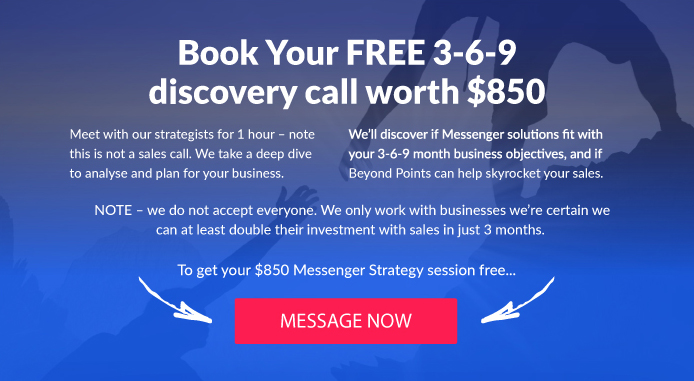You’ve heard that Messenger Marketing can benefit your ecommerce business. But you have to avoid the key mistakes many make to use them to their full potential.
Marketing using bots has become an essential part of the modern ecommerce sector.
With a Facebook Messenger bot, you can stay in touch with existing clients. Plus when combined with targeted ad campaigns, you can attract potential clients with offers and content.
Not only that, consumers love them! We’ve seen open rates of upwards of 84% – as high as the “glory days” of email marketing.
But it’s different from email.
And as powerful as messenger marketing is, you need to understand some important principles in order to use it effectively. Here, we’re going to look at some of the key mistakes that people make when implementing a Messenger marketing strategy.
Mistake #1 – Treating Messenger Marketing Like Email Marketing
This mistake often occurs because people have used email marketing for so long that it’s difficult to comprehend another way to send messages to customers.
When making the transition to Messenger, the temptation is to send long-winded and one-sided messages to people. They don’t respond and the senders ends up wondering where they went wrong.
The solution to this is to take a more conversational approach. Think about how you use Messenger when you’re chatting with your friends. That’s the approach that you want to take with your Messenger marketing.
Design conversations that focus on engaging the user based on what they tell you about themselves. This personalises the experience and makes the user more likely to continue engaging with your Messenger bot.
Mistake #2 – Being Too Formal
Traditional marketing techniques suggest that you should try to present an air of professionalism at all times.
That leads to another key Messenger marketing mistake. Some marketers try to use professional or corporate-sounding language, but it just comes off as stiff and robotic, which doesn’t engage the user.
Again, being more conversational is the solution here. Don’t be afraid of throwing the occasional emoji into the conversation. Use gifs, videos, and images to keep the user’s interest and ensure they keep talking.
Mistake #3 – Taking the “Stamp Collector” Approach
It feels really good to see your subscriber list grow.
In fact, it can feel so good that a lot of marketers and business owners can end up with the “stamp collector” mentality. Instead of using Messenger marketing for engagement, they use it to build a list that they don’t do a whole lot with.
Low engagement and higher operational costs are the end result of this mentality.
Achieving true value in Messenger is about what you do with the audience you have rather than building as large an audience as possible. Use Messenger to re-engage your existing customer base. Importantly, weed out the Messenger subscribers who don’t want to engage with your business anymore.
Mistake #4 – Not Understanding Facebook’s Messenger Rules
Since it’s so easy to talk to a customer via Messenger, there’s a temptation to spam them with a ton of messages.
However, there are rules surrounding how you message people that you need to take into account. The key rule is that there’s a 24-hour window for standard messaging that you need to adhere to. You can send messages outside of this window to a subscriber.
Furthermore, there are limitations in terms of how much promotional content you can send to subscribers.
Failing to follow these rules could lead to Facebook revoking your Messenger privileges.
Keep the 24+1 Rule in mind for your subscriber list. For the first 24 hours, you’re able to send as much promotional and non-promotional content as you want to the new subscriber.
After that 24 hours, you can send as many non-promotional items and one promotional follow-up item.
This resets whenever you experience an engagement with the user. Follow this rule at all times and you’re unlikely to run afoul of Facebook.

Mistake #5 – Not Properly Managing The Audience
Many ecommerce business owners see their Messenger bot builder software through the lens of managing flows and broadcasts.
While that’s part of the equation, this narrow view doesn’t allow you to take full advantage of a bot.
They miss the chance to build hyper-targeted audiences, which results in low funnel conversion.
The solution is to make better use of tags and custom fields with the CRM. Segment your audience based on where they are in your funnel, the products they’ve shown interest in, and any other relevant criteria. From these segments, you can create targeted Messenger campaigns that appeal directly to a specific audience.
Mistake #6 – Treating Messenger Like a Marketing Silo
Some ecommerce business owners treat Messenger marketing as a separate marketing strategy. They don’t integrate it into their other channels.
This results in them missing opportunities to more effectively market their products.
Messenger should be part of an omni-channel marketing strategy. After all, your Messenger bot collects a lot of valuable information about your customers. You can use this information to help you target other campaigns.
Of course, this works both ways as the data you collect from other campaigns can help you to tighten your Messenger marketing.
Mistake #7 – Not Covering the Basic Touchpoints
Every customer that you have went on a journey with your business.
They discovered who you were, learned about you and your products, and engaged with you at several points before making their decision.
The key mistake that many make with Messenger marketing is to not use it to hit on all of these touchpoints. They end up having to hit them manually, which takes more of their time. In the worst-case scenario, they miss the opportunity to engage with a customer when they really need your help.
Defining your sales funnel is the first step to remedying this issue. When you know what customers need to know at each stage of the journey, you can use Messenger to deliver the appropriate messages to them.
Mistake #8 – Not Starting Free Conversations
Many ecommerce business owners believe that they can only start conversations through Facebook ads. They have to pay to engage the customer in the first place before they can start guiding them through their sales funnel.
There are plenty of opportunities to acquire new customers without paid Ads. In fact, you can acquire a customer anywhere you can use a URL or QR code. Think about packaging, flyers, event stands, magazines, business cards. The list is endless.
This mistake may stem from the thought that you can only use Messenger to attract new customers. However, there are also plenty of opportunities to start free conversations with the people who are already on your list.
Of course, you also need a strategy in place to provide instant responses to people who message your business. They’ve taken the initiative, which means there’s usually a defined interest there. Make sure you don’t miss the opportunity to nurture any new leads that come to you for free.
Create a Great Facebook Messenger Strategy
A Messenger marketing strategy gives you the opportunity to market your products to a huge audience.
But you have to avoid the mistakes covered in this article. Messenger is about so much more than blasting your list with content. With the right strategy, you can drive engagement, lower your CPA, and increase your profits.
Perhaps you need a little help with creating your strategy.
That’s where Beyond Points comes in.
We can help you to use Facebook Messenger bots for your ecommerce business. Send us a message to book your strategy session.





